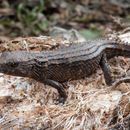pt-BR
nomes no trilho de navegação


For more detailed description of color (often from preserved specimens), see Brown and Alcala (1980).
(Coloration in preservative; Brown and Alcala, 1980)
Dorsal Coloration: dark or dusky brown, uniform or faint to distinct tan to pale brown transverse bands
Band/Stripe Coloration: tan to pale brown, usually 6 or 7light bands between neck and base of tail, 1-3 scale rows in width
Tail Coloration: light bands wider and more distinct than dark bands
Ventral Coloration: near uniform ivory, may have diffused brownish markings on head and throat
Of the 28 currently recognized species of skink in the genus Tropidophorus, four are recognized to occur in the Philippines (T. davaoensis, T. grayi, T. misaminius, and T. partelloi). Commonly referred to as Water or Keeled Skinks, this enigmatic radiation of Southeast Asian lizards consists of species that prefer habitat in and around stream and river systems.
In the Philippines, all four species are commonly observed underneath leaf litter, rocks, and collected piles of debris on the banks and in the middle of stream systems. Their unique morphologies make them easily identifiable in comparison to all other genera of Philippine lizards. Although variation in morphological characters has been documented between populations in the Philippines (Taylor, 1922), Brown and Alcala (1980) were the last to categorize and describe the country's diversity, recognizing only four species. The widespread species, T. grayi, exhibits large differences in adult body sizes between island populations, and likely includes multiple, unique evolutionary lineages in need of recognition.
There are only four recognized species of the genus Tropidophorus that are recongized to occur in the Philippines. Tripidophorus grayi can be distinguished from its congeners by the following combination of characters: (1) keels on dorsal scales of body and tail terminating in moderately to strongly projecting spines; (2) midbody scale rows 24-28; (3) scale rows between parietals and base of tail 30-34; (4) 4th toe lamellae 16-20; (5) frontonasal divided; (6) enlarged preanals 3; (7) head shields with strong keels; and (8) keels on scales of dorsum and tail projecting posteriorly into strong spines (Brown and Alcala, 1980).
This species is widely distributed in the Philippines, and has been recorded from Luzon, Polillo, Masbate, Negros, Panay, Cebu, and Leyte Islands.
Luzon, Visayan (Central), and Mindanao Pleistocene Aggregate Island Complexes (PAIC; Brown and Diesmos, 2002).
This species is often encountered under loose leaf litter and logs on the forest floor as well as along the banks of streams. Individuals are also encountered mid-streams beneath piles of leaves and branches that have collected in the middle of the stream. Other individuals have been collected within rotting logs on the forest floor. The species is recognized to occur in low to mid-elevation forested habitat (< 800 m).
Reported to be ovoviviparous (Brown and Alcala, 1980).
SVL 83.8-119.3 mm (Brown and Alcala, 1980)
Philippines; type in the British Museum; BMNH 1946.8.20.86-88 (syntypes)
Tropidophorus grayi, commonly called the spiny waterside skink[1] or Gray's keeled skink, is a relatively common but secretive skink species, a lizard in the family Scincidae. The species is endemic to the Philippines.
T. grayi lives by rivers and lakes, which gives it the common name waterside skink. Despite the warm climate in its native habitat, it prefers relatively cool temperatures in mountainous areas.
T. grayi has serrated scales (very spiky) which are grey-black in colour, but may also appear in pure black, reddish-brown or wooden-brown colours. The belly is white with or without brown blotches and is smooth and shiny. This makes this species look like a miniature crocodile.
T. grayi is fast and agile. Despite its looks and speed, it is harmless, but it may occasionally bite hard, if handled. When threatened by predators this reptile hides in water. If left to swim in deep water, it may appear to drown, but it actually only plays dead. When removed, it may stay motionless for a few minutes and then return to its normal state. It is also an excellent climber, equipped with claws that can grip tree trunks and other wooden structures.
T. grayi eats worms, insects, small snails, slugs, and small fishes (if it can catch one).
In captivity, it is observed that T. grayi likes to stack itself in piles, like turtles basking in the sun, and would rather stay on dry land than in water. It is becoming quite popular as an exotic pet due to its crocodilian appearance and cheap price in the Philippines.
Like almost any species in the skink family, T. grayi can regrow its tail if severed, but the replacement tail usually is shorter and has fewer spikes than the original tail. Also, the tail of T. grayi is tougher to break than the tail of most other skinks.
The specific name, grayi, is in honor of British herpetologist John Edward Gray.[2]
Tropidophorus grayi, commonly called the spiny waterside skink or Gray's keeled skink, is a relatively common but secretive skink species, a lizard in the family Scincidae. The species is endemic to the Philippines.
Tropidophorus grayi Tropidophorus generoko animalia da. Narrastien barruko Scincidae familian sailkatuta dago.
Tropidophorus grayi Tropidophorus generoko animalia da. Narrastien barruko Scincidae familian sailkatuta dago.
Tropidophorus grayi est une espèce de sauriens de la famille des Scincidae[1].
Cette espèce est endémique des Philippines. Elle se rencontre sur les îles de Luçon, de Polillo, de Masbate, de Panay, de Negros, de Leyte, de Cebu, de Catanduanes et de Samar[2].
Cette espèce est nommée en l'honneur de John Edward Gray[3].
Tropidophorus grayi là một loài thằn lằn trong họ Scincidae. Loài này được Günther mô tả khoa học đầu tiên năm 1861.[2]
Tropidophorus grayi là một loài thằn lằn trong họ Scincidae. Loài này được Günther mô tả khoa học đầu tiên năm 1861.